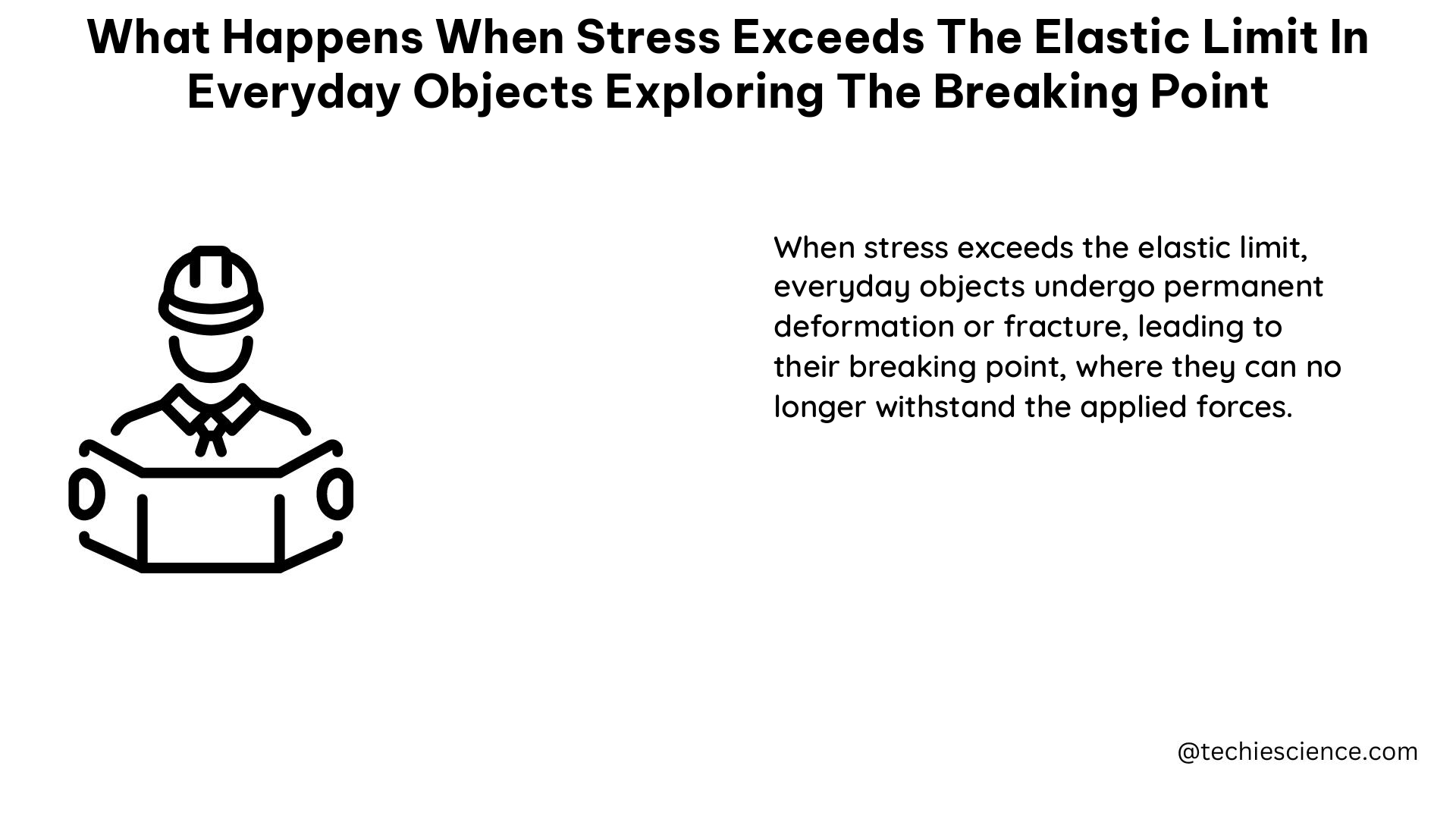When stress exceeds the elastic limit in everyday objects, it can lead to permanent deformation, also known as plastic deformation. This means that the object will not return to its original shape when the stress is removed, but instead, it will remain deformed. The elastic limit is the maximum amount of stress that a material can handle before it starts to deform plastically.
Understanding the Stress-Strain Curve
To comprehend what happens when stress exceeds the elastic limit, it is essential to examine the stress-strain curve of a material. The stress-strain curve is a graph that illustrates the relationship between stress and strain. Stress is defined as the force applied per unit area, while strain is defined as the partial derivative of length with respect to the original length.
The stress-strain curve of a material can be divided into three distinct regions:
- Elastic Region: In this region, the material behaves elastically, meaning that it returns to its original shape when the stress is removed.
- Plastic Region: In this region, the material deforms plastically, meaning that it does not return to its original shape when the stress is removed.
- Rupture Region: In this region, the material breaks.
The elastic region is characterized by a linear relationship between stress and strain. The slope of the stress-strain curve in this region is constant and is known as the elastic modulus or Young’s modulus. The elastic modulus is a measure of the stiffness of a material.
The Elastic Limit

The elastic limit is the point at which the material transitions from the elastic region to the plastic region. Beyond the elastic limit, the material starts to deform plastically. The amount of plastic deformation that occurs depends on the amount of stress that is applied and the duration of time that the stress is applied.
The elastic limit of a material can be determined through a standard test procedure. A test sample is prepared that is free of any defects or damage, and a known amount of stress is then applied to the sample using a mechanical testing machine or a similar instrument. The stress is gradually increased until the material begins to exhibit permanent deformation, and this point is known as the elastic limit of the material.
Exceeding the Elastic Limit in Everyday Objects
When the stress exceeds the elastic limit in everyday objects, it can lead to a variety of consequences. For example, a paperclip that is bent too far will not return to its original shape, and a wire that is stretched too far will break. The amount of stress required to exceed the elastic limit depends on the material that the object is made of.
The following table provides examples of everyday objects and the typical elastic limits of the materials they are made of:
| Everyday Object | Material | Elastic Limit (MPa) |
|---|---|---|
| Paperclip | Steel | 200-300 |
| Rubber Band | Rubber | 1-5 |
| Aluminum Can | Aluminum | 70-100 |
| Copper Pipe | Copper | 50-70 |
| Glass Bottle | Glass | 50-100 |
As you can see, the elastic limit varies significantly depending on the material. Steel, for example, has a much higher elastic limit than rubber, which means that a paperclip can withstand more stress before it starts to deform plastically compared to a rubber band.
Consequences of Exceeding the Elastic Limit
When the stress exceeds the elastic limit in everyday objects, the consequences can range from minor deformation to complete failure. Some common consequences include:
- Permanent Deformation: The object will not return to its original shape when the stress is removed, leading to a permanent change in its appearance and functionality.
- Reduced Strength and Durability: Exceeding the elastic limit can weaken the material, making the object more susceptible to further deformation or even breakage under future stress.
- Safety Hazards: In some cases, exceeding the elastic limit can lead to the sudden and catastrophic failure of an object, posing a safety risk to the user.
For example, a paperclip that has been bent too far may become weaker and more prone to breaking, potentially causing injury if it snaps. Similarly, a copper pipe that has been overstressed may develop cracks or leaks, leading to water damage or even flooding.
Preventing Exceeding the Elastic Limit
To prevent exceeding the elastic limit in everyday objects, it is essential to understand the material properties and the expected stress levels that the object will encounter during its use. This information can be used to design the object with appropriate safety factors and to provide guidance to users on the proper handling and use of the object.
Some strategies for preventing exceeding the elastic limit include:
- Material Selection: Choosing materials with higher elastic limits can help ensure that the object can withstand the expected stress levels without deforming plastically.
- Design Optimization: Designing the object with appropriate geometry, thickness, and reinforcements can help distribute the stress more evenly and prevent localized stress concentrations that could exceed the elastic limit.
- User Education: Providing clear instructions and guidelines to users on the proper handling and use of the object can help prevent them from inadvertently exceeding the elastic limit.
By understanding the principles of stress and strain, and the consequences of exceeding the elastic limit, engineers and designers can create everyday objects that are more durable, reliable, and safe for users.
References:

The lambdageeks.com Core SME Team is a group of experienced subject matter experts from diverse scientific and technical fields including Physics, Chemistry, Technology,Electronics & Electrical Engineering, Automotive, Mechanical Engineering. Our team collaborates to create high-quality, well-researched articles on a wide range of science and technology topics for the lambdageeks.com website.
All Our Senior SME are having more than 7 Years of experience in the respective fields . They are either Working Industry Professionals or assocaited With different Universities. Refer Our Authors Page to get to know About our Core SMEs.